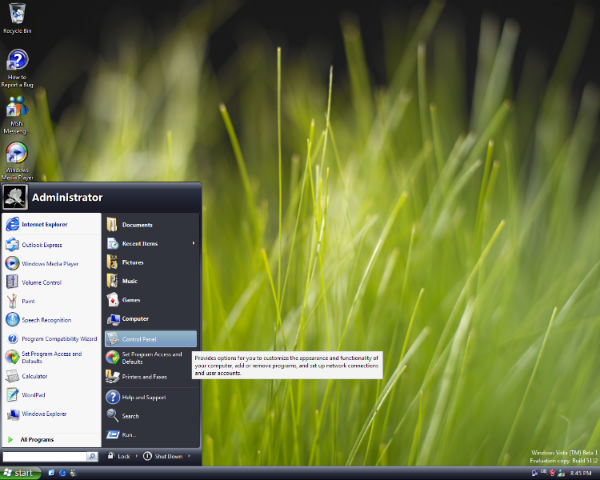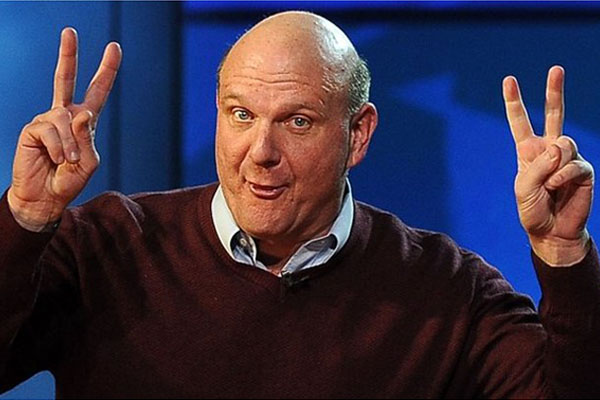He took the helm in the good old days, when work was already underway on XP, one of Redmond’s most successful operating systems, backed by an impressive array of other products and initiatives, such as the Xbox push.
It’s been downhill ever since.
Vista
Ballmer once described Vista as his biggest regret and who are we to argue. Vista was terrible, but in an ironic twist it did help fuel the need for new, faster hardware. It was just too bloated to run properly on old XP boxes, so people had to upgrade. To fix the mess Windows 7 was a lot more streamlined and it was followed up by the even leaner Windows 8. As a result, most Vista machines are still perfectly capable of running the latest version of Windows and for many consumers there is simply no incentive to upgrade, unless they spill a cup of tea on their laptop.

However, the biggest problem with Windows was and still remains relatively slow development and the reliance on an ancient business model that no longer works. Apple and Google try to keep things interesting with tons of updates and new features, free of charge. Microsoft’s updates are basically fixes and new versions of Windows still cost an arm and a leg, offering very little in return.
Windows 8 aka the new Vista
Windows 8.x is proof that Microsoft still doesn’t get it. It was designed with tablets in mind at a time when there was simply no hardware to take advantage of its new interface.
There’s still very little in the way of touch enabled apps. As an added bonus, corporate users hate the new interface, which has failed on both fronts. Windows 8 has not been very successful in the tablet space, but at the same times the tablet tweaks also made it unappealing for desktop users and businesses.
It is rumoured that Microsoft employees are internally referring to Windows 8 as “the new Vista.”
Epic hardware flops
There was no shortage of hardware flops during Ballmer’s tenure, either. Remember the Zune, or better yet the Kin? Neither do we and Microsoft is trying to forget them. In addition to wasting millions on Zune, Microsoft also wasted half a billion on the developer of Sidekick and Kin, which was appropriately named Danger. Microsoft’s hardware curse is still going strong, thanks to the Surface.
Investing in Danger wasn’t the only bad call. Seven years ago Microsoft also took a massive $6.2 billion write down for digital marketing outfit aQuantive.
Wasteful spending continued with Microsoft’s efforts to take on Google in online services and search. All the efforts failed spectacularly, but cumulatively they cost the company a few more billion. Last year Microsoft took another $900 million hit thanks to the Surface RT. We will give the first gen Xbox a pass, since it was marred by a huge write-off, but eventually the Xbox division recovered.
Pricey acquisitions
While Ballmer’s Microsoft was trying to compete with Google online, it was outmanoeuvred by Google on its own turf. Google acquired Android eight years ago for just $50 million, one tenth of what Microsoft paid for Danger. Google is now the biggest mobile OS on the planet, the Kin is just another embarrassing footnote in Microsoft’s history.
Google also scooped up YouTube, DoubleClick, AdMob and topped it all off with Motorola Mobility, which it sold off to Lenovo, but not entirely. Google was just a lot better at picking winners than Ballmer and his gang. Microsoft did get Skype, but it paid $8.5 billion for the privilege and it did it only after Skype virtually destroyed its own Messenger.
And then there's aQuantive...
Throwing cash at problems
The Skype deal is indicative of another problem. Mighty Microsoft paid $8.5 billion to buy a competitor, as it apparently couldn’t bring its own services up to speed for what is a huge amount of cash.
Google probably could and would, Apple too, but for some reason Microsoft’s culture revolves around throwing cash at problems rather than solving them in-house. It is just a weird and oppressive culture that could work in the nineties, when Microsoft was king of the world and didn’t have much competition to worry about.
Too slow to adapt
Microsoft tends to get blamed for missing the boat on social networking, but in all fairness most tech companies did and even Google didn’t exactly nail it with Google+. However, the problem goes beyond social networking, which is something Microsoft probably shouldn’t mess around with in the first place.
Microsoft failed to harness the full potential of third-party products and services that grew at a staggering rate. These include social networks, tablets, smartphones and web-based services. The company was simply too slow to respond to emerging trends and it paid a huge price for its hubris. Android dominates the smartphone market, Apple has a firm grip on tablets, Google is still unchallenged in online services and overall the Windows platform is a lot less relevant than a few years ago.
Microsoft remains OS-centric and this antiquated approach is still stifling innovation.
Mobile
But Microsoft’s biggest failure under Ballmer was undoubtedly mobile. Ballmer arrogantly laughed at the iPhone and he clearly failed to recognize the threat posed by iOS and Android. As a result Microsoft’s market share in the smartphone market is virtually non-existent. It also teamed up with Nokia, another outfit that didn’t get it, which was only fitting.
If phones weren’t to be, then Microsoft had another big chance in tablets, but it botched that, too. It even decided to cripple its own Windows RT platform by refusing to integrate Outlook, while at the same time it refused to release Office for iOS and Android, which didn’t help its own products and just allowed competing products to emerge.

The big question now is what Satya Nadella plans to do next? Cleaning up the mess that is Microsoft won’t be easy, it will be a bit like cleaning Hunter S. Thompson’s hotel room. However, there are some positive developments. Windows 8.1 hybrids are coming and they are pretty good. Windows Phone has matured and it is gaining share in many markets. Microsoft remains a powerhouse in enterprise and on the other side of the spectrum the new Xbox appears to be doing quite well.
It’s high time for a Redmond renaissance and we can only hope Nadella can pull it off. He can also count on input and support from Bill Gates, who was probably brought it to reassure investors, but his role should not be underestimated.




